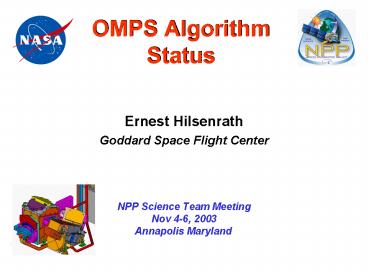OMPS Algorithm Status - PowerPoint PPT Presentation
1 / 10
Title:
OMPS Algorithm Status
Description:
NCEP demonstrated and is implementing total and profile ozone to improve weather forecasts ... Ozone OAT NASA, NOAA, NRL, U of Md have provided advice to IPO ... – PowerPoint PPT presentation
Number of Views:54
Avg rating:3.0/5.0
Title: OMPS Algorithm Status
1
OMPS AlgorithmStatus
- Ernest Hilsenrath
- Goddard Space Flight Center
- NPP Science Team Meeting
- Nov 4-6, 2003
- Annapolis Maryland
2
Ozone Mapper Profiler Suite OMPS)
- OMPS is three instruments with NASA and ESA
heritage - TOMS, SBUV, SOLSE, OMI
- GOME OSIRIS, SCIAMACHY
- Each instrument employs a CCD for UV/VIS
hyperspectral imaging - Nadir column ozone mapping
- Nadir profile
- Limb profile
- Total ozone algorithm developed using CrIS
Instrument System Contractors
3
Ozone IORD-II 4.1.6.2.4(accuracy, precision,
stability)
Threshold Objectives
Tougher than TOMS and SBUV
4
OMPS Objectives
- Continue TOMS-SBUV/2 global total ozone
- Ozone recovery will be slower (½) than the
decrease detected to date (0.5/year-column) - Numerical Weather Prediction
- Assimilated GOME data used to predict 2002
Antarctic ozone hole - NCEP demonstrated and is implementing total and
profile ozone to improve weather forecasts - Naval weather forecast to include assimilated
ozone profiles - OMPS is capable of additional CDR products
- Tropospheric ozone
- Aerosol distribution and characteristics
- UV irradiance and surface reflectivity
5
OMPS end to end Processing(S. Bennett BATC)
NPOESS
OMPS Sensor
SDR Processing
Scene or solar Radiance
Earth view RDR
Calibration RDR
Instrument Calibration Determination
Calibration
SDR Trending
SDR formation
EDR Processing
Ozone Retrieval
6
Algorithm Status
- Ball/Raytheon responsible for development of RDR,
SDR, EDR algorithms - Rely on TOMS, SBUV/2 SOLSE heritage algorithms
- Four algorithms delivered
- Total column (TOMS)
- Nadir profile (SBUV/2)
- Limb profile (SOLSE
- CrIS IR Total column (AIRS)
- Ozone OAT NASA, NOAA, NRL, U of Md have
provided advice to IPO since 1997 Down select,
hardware, R/T- algorithm, and Cal/Val - Will not discuss RDR and SDR algorithms CCDs
were significant enhancements over heritage, but
added new challenges
7
Total ozone mapping algorithm
- TOMS heritage with improvements needed to meet
EDR accuracy and precision - Takes advantage of multiple wavelengths
- Multiple scattering tables
- Non-homogeneous scenes (VIIRS)
- Cloud fraction and top pressure (VIIRS)
- Ozone profile shape (improved climatology)
- Tropospheric ozone (improved climatology)
- Improved aerosol corrections
- Self consistency checks for soft validation
- Performance meets requirements
- ATBD posted on IPO website
- Science code delivered to NGST Dec 2002
- Some problems uncovered will be fixed
8
Nadir Profile Algorithm
- Primarily adaptation of NASA vs 6 ozone profile
algorithm - Makes use of hyperspectral capability
- Requires Mapper total ozone
- Has slightly better SNR than heritage SBUV/2
- Performance meets requirements
- ATBD posted on IPO website
- Science code delivered to NGST Dec 2002
- Some problems uncovered will be fixed
- EOL SNR at shortest wavelength issue of the day
- NASA produced vs 8 ozone profile algorithm
- Better climatology (O3, temp, aerosols)
- Better RT
- Better internal (soft) calibration
- No plans to put in SSPR baseline
9
IR Total Ozone Algorithm (CrIS)
- AER selected with BATC to provide TC ozone for
night-time coverage, polar night, SAA - Heritage IRIS, TOVS, AIRS show feasibility
- Four bands using 1305 CrIS channels
- Performance meets requirements - most of the time
- Algorithm science code delivered ATBD posted on
IPO website - Test with AIRS observations highly desirable
- NGST Position
- No contractual requirements found regarding TC-IR
EDR algorithms. BATC contract CWBS shows a P3I
product with no specs. - Next step currently being pursued.
- Briefing to NGST management is in preparation
- IPO Position NGST must accept and implement
BATC deliverables
10
Limb Profile Algorithm
- Limb scattering heritage SOLSE, SCIAMACHY,
OSIRIS - Coverage similar to SBUV/2
- Vertical resolution can meet 3 km EDR
- Several major challenges still unresolved
- Surface inhomogeneity more R/T modeling
- LOS ozone inhomgeneity - Tomography
- Aerosols complications requires retrievals
- Latency issues to account for corrections
- Pointing errors accuracy sensitive
- More tests with heritage data needed
- Profile EDR not met
- Some SDR problems
- EDR science code not integrated or tested
- Further government investments likely

